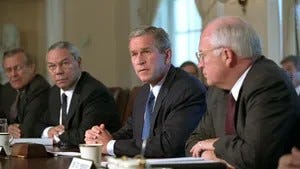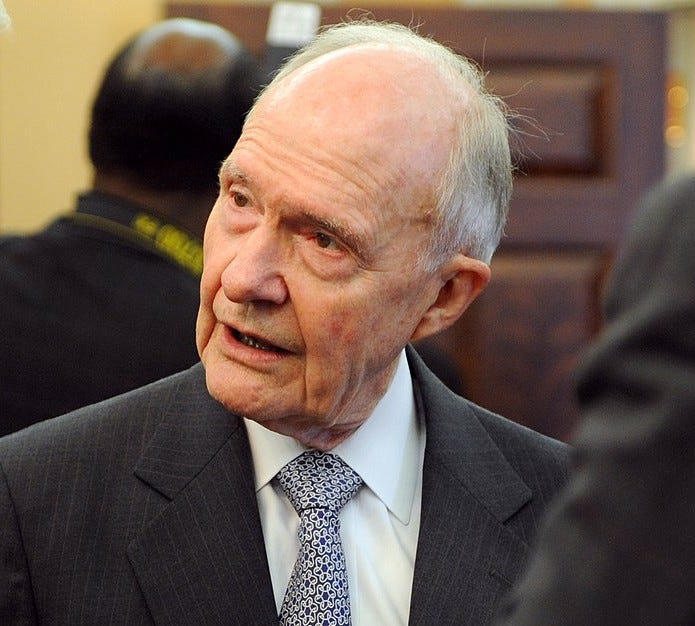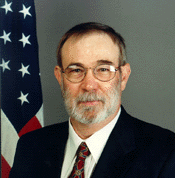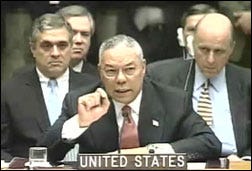(Originally published on August 14, 2024.)
I will need three essays to explain the impact on American history of the egregious intelligence failure that facilitated our March 2003 invasion of Iraq. This first essay deals with the maneuvering within the Bush Administration during the lead up to the invasion. The second essay will deal with the unexpected and costly quagmire that Iraq became from March 2003 until January 2009. The third essay will deal with the adverse long-term impact of the war on America itself. It is a sad story.
Truth in advertising – In 1997, I served as CIA Director George Tenet’s personal aide. I respect the man. I knew him to be an honest and decent human being.
On Inauguration Day 2001, the new Bush Administration was divided on what policy to adopt towards Iraqi Dictator Saddam Hussein. Vice President Dick Cheney and Defense Secretary Donald Rumsfeld considered Saddam a thug and hoped to drive him from power, by war if necessary. Secretary of State Collin Powell likewise considered Saddam a thug but no longer considered Saddam’s Iraq to be the danger it had been a decade previously. Powell supported a patient policy of isolating and containing Saddam.
President George W. Bush had an additional personal grudge against Saddam – in 1993, the dictator had tried to assassinate the President’s father, former President George H. W. Bush. The younger Bush would be more than happy to chase the dictator, thug, and would-be assassin from power but he knew he could not ask the American People to support an invasion of Iraq without a clear and present danger.
George Tenet and 9/11
CIA Director George Tenet was a hold-over from the Clinton Administration. His job was not to decide policy. His job and the job of the CIA was to report the facts as best we knew them on all foreign threats to the US and give an honest assessment of our confidence in those alleged facts. The threat that kept Tenet awake at night in August 2001 was Osama bin Laden not Iraq.
On 11 September 2001, Bin Laden’s Al Qaeda terrorists struck the American homeland. For the following three months, the President focused like a laser on holding to account Al Qaeda and their Afghan allies in the Taliban. Because of its agility and speed, the CIA took the lead in this accounting. Tenet transformed from a relative outsider to one of the President’s favorites.
On 15 September at a Camp David strategy meeting, Deputy Defense Secretary Paul Wolfowitz tried to implicate Saddam in the 9/11 attack and, thus, provide a clear and present reason to invade Iraq. Wolfowitz insisted that there was at least a 10 percent chance, and perhaps a 50 percent chance, that Saddam had helped Osama carry out the 9/11 attack. He said, “We’ve got to make sure we go ahead and get Saddam out at the same time. It’s a perfect opportunity” (1).
Tenet was dubious. CIA had high confidence that it knew the true facts. Al Qaeda carried out the attack. Osama bin Laden was the mastermind behind it. Saddam was a thug, but there was no evidence that he was involved in 9/11 and plenty of reason to believe that he was not.
The President deferred judgement. At a White House meeting on 17 September he said, “I believe Iraq may have been involved but I am not going to strike them now. I don’t have the evidence at this point” (Also 1).
Bush Pivots
After the fall of Kabul on 13 November, things were going our way in the War on Terror. Osama bin Laden fled to his redoubt in Tora Bora. His death or capture was expected any day. At that moment, the US government lost focus.
On 27 November, Defense Secretary Rumsfeld ordered Commanding General Tommy Franks of the Central Command to switch gears and start planning for the invasion of Iraq. This proved premature. Distracted by Iraq War planning, Franks allowed Bin Laden to escape into Pakistan circa 14 December. It would take a decade to finally bring Bin Laden to justice (2).
On 28 December, Franks confidently briefed the Iraq invasion plan to the President at his ranch in Crawford, Texas. CIA Director Tenet carefully sounded a note of caution. The President concluded the meeting with the comment, “Saddam is a threat. Invasion is an option.”
On 29 January 2002, President Bush delivered his first State of the Union Address in what became known as “The Axis of Evil Speech.” Regarding Iraq, he inclusively described Saddam’s thuggery, his support of terrorism, and his acquisition of nuclear weapons. He said, “Iraq continues to flaunt its hostility towards America and to support terror. The Iraqi regime has plotted to develop anthrax and nerve gas and nuclear weapons for over a decade. This is a regime that has already used poison gas to murder thousands of its own citizens, leaving the bodies of mothers huddled over their dead children. This is a regime that agreed to international inspections, then kicked out the inspectors. This is a regime that has something to hide from the civilized world.”
A week later, a published poll showed that 75% of Americans (a) thought that Saddam had aided Bin Laden launch the 9/11 attack and (b) would support attacking Iraq.
Tenet continued to forthrightly contest the idea that Saddam was involved in 9/11. What brought this issue to a head, however, was the remarkable 15 August op-ed in the Wall Street Journal by Brent Scowcroft entitled, “Don’t Attack Saddam.” Scowcroft was National Security Advisor to the first President Bush and many believed the first Bush’s alter ego.
In the op-ed, Scowcroft wrote, “Given Saddam's aggressive regional ambitions, as well as his ruthlessness and unpredictability, it may at some point be wise to remove him from power. Whether and when that point should come ought to depend on overall U.S. national security priorities. Our preeminent security priority -- underscored repeatedly by the President -- is the war on terrorism. An attack on Iraq at this time would seriously jeopardize, if not destroy, the global counter terrorist campaign we have undertaken.”
Vice President Cheney and Defense Secretary Rumsfeld were furious with the public lecturing by Scowcroft. The President probably was too, but he took note. He doubled down on weapons of mass destruction, particularly nuclear weapons, as the clear and present danger that might justify an invasion.
What We Believed vs What We Knew
In 2001, most people at CIA, including Tenet, honestly feared that Saddam was rebuilding his nuclear weapons program along with his other WMD programs. Our fear was a result of the 1990-91 Iraq War when Americans were shocked to discover that Saddam was only months away from having a nuclear weapon and had plentiful stockpiles of biological and chemical weapons.
We lacked compelling evidence to prove our 2001 fears, however. We attributed this lack of compelling evidence to Saddam’s alleged success in hiding these programs from outside observers as he had succeeded in doing a decade earlier.
To develop the compelling evidence, we in CIA’s Operation Directorate aggressively set about doing what we do: recruiting spies who ideally have direct access to the secrets we want or, at least, spies who talk confidentially with the people who do have direct access. The Iraqis with direct access refused to talk with us. In their confidential conversations with other people, they claimed that work on the nuclear and biological programs had stopped after the 1990-91 war. We were incredulous and assumed that they were either lying or did not know the truth.
The analysts in CIA’s Intelligence Directorate sifted through tea leaves in hopes of gaining insight. They were particularly interested in any indication that Iraq was rebuilding its capability to produce highly enriched uranium for use in nuclear weapons. In this regard, two suspicious events in 2001 caught their eye, (a) reports that Iraq had tried to procure 500 tons of “yellowcake” uranium powder from Niger and (b) the attempted Iraqi purchase of 60,000 high strength aluminum tubes that the UN prohibited Iraq from buying.
By September 2002, CIA had dismissed the alleged Iraqi attempt to procure Nigerian yellowcake powder. The aluminum tubes continued to be the subject of considerable controversy, however. Generalists from big CIA and big DIA insisted that the tubes were to make centrifuges used to transform yellowcake uranium powder into highly enriched uranium. Centrifuge experts with PhD’s and decades of experience from the little Department of Energy asserted that the tubes were technically unsuitable for use as centrifuges.
The Misleading NIE of October 2002
On 10 September, the Chairman of the Senate Select Committee on Intelligence, Democratic Senator Bob Graham, sent a letter to Tenet requesting that the Intelligence Community write a National Intelligence Estimate “on the status of Iraq’s programs to develop weapons of mass destruction.” This NIE was a matter of prudent due diligence since Congress was preparing to vote in October on whether to authorize the use of force by the President against Iraq.
In his book, At the Center of the Storm, Tenet admits that he was reluctant to agree with Graham’s request and it is easy to see why. The CIA had little evidence that Iraq was rebuilding its weapons of mass destruction programs, particularly its nuclear weapons program. He honestly believed that Saddam was secretly doing so but he could not prove it. Tenet had no real choice, however. On 12 September he directed the National Intelligence Council to produce the NIE prior to the Congressional vote on the use of force.
The National Intelligence Officer for Strategic Programs, Bob Walpole, was put in charge of coordinating the NIE. When given this assignment, Walpole went to see Tenet and said, “I just don’t believe in this war. Some wars are justifiable, but this one is not” (3). Despite his misgivings, Walpole agreed to coordinate the NIE at Tenet’s urging.
A first draft of the NIE was rushed to production on 23 September and sent to all the Intelligence Community agencies for coordination. On 1 October, Tenet chaired a meeting of the Intelligence Community agencies to discuss, debate, and approve the final document. The document was quickly delivered to Congress that same evening.
You can read the declassified “Key Judgements” of the NIE along with the formal dissent of it by the State Department on the website of the Office of the Director of National Intelligence. I would recommend you do so.
On the most crucial issue, nuclear weapons, the NIE downplayed the strong disagreement amongst the Intelligence Community agencies. It makes factually unsupported assertions – “In the view of most agencies, Baghdad is reconstituting its nuclear weapons program” – to justify provocative projections – “If left unchecked, Iraq probably will have a nuclear weapon during this decade.”
We shall see that Walpole certainly knew how weak the evidence was on nuclear weapons. As Director of Central Intelligence, Tenet was responsible for knowing this as well.
In contrast to the cryptic and misleading main text of the NIE, the formal dissent by the State Department, written by Assistant Secretary Carl Ford, is noteworthy for its clarity … and because it proved correct.
It says:
“State/INR Alternative View of Iraq's Nuclear Program
The Assistant Secretary of State for Intelligence and Research (INR) believes that Saddam continues to want nuclear weapons, and that available evidence indicates that Baghdad is pursuing at least a limited effort to maintain and acquire nuclear weapon related capabilities. The activities we have detected do not, however, add up to a compelling case that Iraq is currently pursuing what INR would consider to be an integrated and comprehensive approach to acquire nuclear weapons. Iraq may be doing so, but INR considers the available evidence inadequate to support such a judgment. Lacking persuasive evidence that Baghdad has launched a coherent effort to reconstitute its nuclear weapons program, INR is unwilling to speculate that such an effort began soon after the departure of UN inspectors or to project a timeline for the completion of activities it does not now see happening. As a result, INR is unable to predict when Iraq could acquire a nuclear device or weapon.
In INR's view Iraq's efforts to acquire aluminum tubes is central to the argument that Baghdad is reconstituting its nuclear weapons program, but INR is not persuaded that the tubes in question are intended for use as centrifuge rotors. INR accepts the judgment of technical experts at the U.S. Department of Energy (DOE) who have concluded that the tubes Iraq seeks to acquire are poorly suited for use in gas centrifuges to be used for uranium enrichment and finds unpersuasive the arguments advanced by others to make the case that they are intended for that purpose. INR considers it far more likely that the tubes are intended for another purpose, most likely the production of artillery rockets. The very large quantities being sought, the way the tubes were tested by the Iraqis, and the atypical lack of attention to operational security in the procurement efforts are among the factors, in addition to the DOE assessment, that lead INR to conclude that the tubes are not intended for use in Iraq's nuclear weapon program.”
Unfortunately, the State Department dissent was ignored. The “Authorization for Use of Military Force Against Iraq” was introduced to Congress on 2 October. It passed the House of Representatives by 296 vs 133 on 10 October and it passed the Senate passed by 77-23 on 11 October (4). It was signed into law by the President on 16 October.
The Mistaken Slam Dunk
According to Tenet’s book, in early December 2002, White House officials asked the CIA to prepare a briefing for the President that could be declassified and made public that Saddam possessed WMD. The White House officials said they were looking for an “Adlai Stevenson moment,” a reference to Stevenson’s famous October 1962 presentation to the UN Security Council during the Cuban Missile Crisis. Bob Walpole, who would normally have provided such a Presidential briefing, warned the White House that our evidence regarding Iraq WMD was nowhere near as categorical as Stevenson’s 1962 presentation.
Given the importance, Tenet asked CIA Deputy Director John McLaughlin to provide the briefing for the President, the Vice President, the President’s Chief of Staff, and his National Security Advisor. McLaughlin was a distinguished, thirty-year veteran of the Agency, well known for his calm, clear, and factual briefings. He prepared carefully for this important briefing.
At the conclusion of the briefing on 21 December, the President said politely, “Nice try, but I don’t think this is something that Joe Public would understand or would gain a lot of confidence from”. The President turned to Tenet and asked, “Is this the best we’ve got?” Had Tenet just replied “yes” it would have greatly complicated the President’s decision to invade Iraq. If neither WMD nor terrorism were our clear and present danger, then what was?
But Tenet did not reply yes. He told President that, “strengthening the public presentation was a slam dunk” (5).
You Have Gotten the President Way Out on a Limb
On 28 December, McLaughlin and Walpole met with the President’s National Security Advisor, Condoleezza Rice, and her staff to improve upon the previous week’s briefing. The staffers suggested drawing from the NIE to bolster the public argument that Saddam possessed WMD.
Walpole noted that the strongest case in the NIE was for Saddam having biological weapons. The case for chemical weapons was based largely on analytical inference. The weakest case was nuclear for which there were sharply differing views within the Intelligence Community.
But the NIE Key Judgements had stated “In the view of most agencies, Baghdad is reconstituting its nuclear weapons program.” and “If left unchecked, Iraq probably will have a nuclear weapon during this decade.” Rice turned to McLaughlin and said, “You have gotten the President way out on a limb on this” (6).
Walpole seethed at Rice’s comment. He knew that in July – well before the NIE – Rice had told Richard Dearlove, the head of British Intelligence, that the decision to invade Iraq was already made. Walpole had never thought the war was justified. He did not want to be responsible for coordinating the NIE and had only done so out of loyalty to Tenet. Now, he felt he was being set up as the fall guy should something go wrong.
Thereafter, Walpole refused to allow the White House to push him any further than what he had already written in the NIE. On 6 January 2003, Deputy National Security Advisor Steve Hadley told Walpole that McLaughlin’s presentation was weak on nuclear weapons and needed to be beefed up. Walpole shot back that the presentation was weak on nuclear weapons because the factual evidence was weak. On 24 January, Hadley asked Walpole for information on what Saddam needed to develop nuclear weapons (7). Walpole simply faxed him 24 pages of relevant information from the NIE. To all intents and purposes, the White House and CIA stopped talking to each other about Iraq.
Colin Powell’s Presentation to the UN
Secretary of State Powell never considered resigning from the Administration despite the State Department dissent from the NIE and despite his sharp differences on Iraq policy with Vice President Cheney and Defense Secretary Rumsfeld. The decision for war or peace was ultimately the President’s, and to the core of his being Powell was a soldier sworn to obey the legal orders of his Commander in Chief. On 13 January 2003, the President told Powell he had decided on war and asked, “Are you with me on this? I want you with me.” Powell replied, “Yes, sir. I will support you. I am with you, Mr. President.”
Because of his wide credibility, Powell was asked to give the “Adlai Stevenson” presentation to the UN Security Council. He agreed to do so but made it clear that he would draft his own speech. Condoleezza Rice suggested that he speak on three consecutive days, first on terrorism, second on human rights, and finally on WMD. Powell said no, he would speak only once and focus on WMD. The Vice President’s Office provided a 59 page “improvement” of the McLaughlin presentation. Powell rejected it out of hand and scolded the author, the Vice President’s Chief of Staff Scooter Libby, “What are you guys thinking, giving me a draft like that.”
Powell’s final presentation was masterful and, as far as he knew, honest. The first half focused on our legitimate fears about what Saddam might be up to in 2003 based on our certain knowledge of what he had done in the early 1990’s. The second half focused on our less certain intelligence about WMD activity as of 2003, which per Walpole was strongest for biological, inferential for chemical, and weak for nuclear. For visual emphasis, Powell had Tenet sit behind him in full camera view.
Powell’s presentation hardened the resolve of people in America to invade Iraq but changed no minds amongst the nations sitting on the UN Security Council. The US withdrew its request for a supportive UN Resolution. Of special note - even Germany remained opposed to the invasion of Iraq.
The Duelfer Report
After the invasion, in April 2004, CIA publicly released the final report of Charles Duelfer who had been assigned by the Agency to go to Iraq and search for evidence of Saddam’s WMD programs. The report concluded that Saddam did not possess stockpiles of biological, chemical, or nuclear weapons at the time of the invasion in March 2003, and that he had no active program to produce them. (8)
The intelligence evidence that Powell had presented about Saddam’s biological weapons was determined to be made up out of whole cloth. It was provided to CIA by an Iraqi defector code named CURVEBALL who was living in Germany under German government protection. Well after the information was shown to be fabricated, an unseemly bout of finger pointing broke out in public amongst senior CIA officials over who was to blame. I don’t know who is to blame, but I do know that the reputation of the entire CIA was irreparably damaged by the public bickering.
Assessment of CIA Performance
As we shall see in my next essay, the 2003 invasion of Iraq has proven to be one of the worst foreign policy decisions the United States has ever made with painful consequences for the American People. There is plenty of legitimate blame to share for this decision.
The purpose of my Spy’s Guide to American History, however, is to assess the performance of the CIA as the lead agency of the US Intelligence Community. How did our collectors do, how did our analysts do, how did our leadership do?
Using our simple system of (+) for success, (-) for failure, and (o) for neutral, CIA collectors clearly get a (-) for a spectacular failure. Our star source, CURVEBALL, turned out to be a fabricator who just made up his story. CIA never even talked to the man. We got information from him via the German government. We had very little independent ability to assess his reliability. Separately, we dismissed as unreliable other Iraqis who claimed that work on their nuclear and biological programs had stopped after the 1990-91 war ... which turned out to be true.
CIA analysts as personified by Bob Walpole get a (-) for failure. Walpole knew that the factual evidence related to Saddam’s nuclear weapons program was weak. Yet he was responsible for the NIE which said, “Baghdad is reconstituting its nuclear weapons program” and “Iraq probably will have a nuclear weapon during this decade.” You cannot have it both ways.
As for CIA leadership, George Tenet believed that Saddam was rebuilding his WMD programs including his nuclear weapons program, but he knew that proving it was not a slam dunk. Tenet admits in his book that the NIE should have said that “the intelligence was not sufficient to prove beyond a reasonable doubt that Saddam had WMD.” He admits that he let the American People down (9). For that failure, Tenet deserves a (-).
(1) Steve Coll, The Achilles Trap, page 194.
(2) For the full story see Bruce Held, 9/11 – The Tragic, 20 Year Aftermath in Afghanistan, (A Spy’s Guide to American History, Substack).
(3) George Tenet, At the Center of the Storm, page 323.
(4) Senator Graham who asked for the NIE voted against the Authorization for Use of Force.
(5) Bob Woodward, Plan of Attack, page 249 & George Tenet, At the Center of the Storm, page 362.
(6) George Tenet, At the Center of the Storm, page 370.
(7) George Tenet, At the Center of the Storm, page 371.
(8) George Tenet, At the Center of the Storm, page 415.
(9) George Tenet, At the Center of the Storm, page 339.










In his 2013 article, "In Pursuit of the Squared Circle: The Nosenko Theories Revisited," former CIA officer W. Alan Messer seems to think Curveball was working for the Russians.